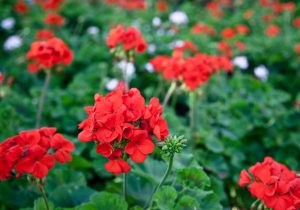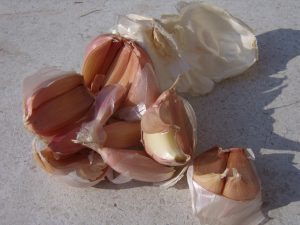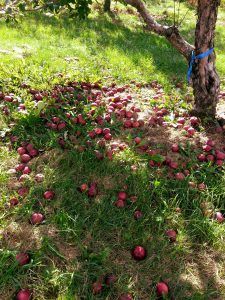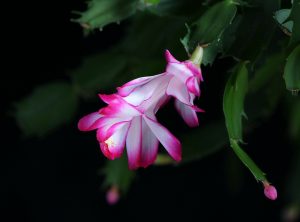It’s “Trick or Treat” month! With harvest season in full swing, October is loaded with treats delicious treats! Unless you are living in a cave, you have witnessed by pumpkin, apple and nut flavors added to just about every product on the market. Be sure to store your harvested treats correctly and you can enjoy them during the long winter months. The trick this month is to prepare your garden for winter. Stay on top the chores that will protect your plants and soil from the rainy winter weather. Something as simple as applying a blanket of mulch to your soil will tuck it in nicely for the chilly season ahead, and just might help you burn off a few of those treats!
Flower Gardens

Some annuals can be saved for next year! Lift geraniums, begonias and dahlias from the soil now and store them in the garage for the winter. When spring arrives replant them in the garden. Fertilize as needed and enjoy them for another season.
Remove any unwanted annuals or dead foliage. Cut down perennials as needed. Now that the ground level is more visible, this is a good time to apply a layer of mulch to rejuvenate the soil, insulate plant roots and suppress weeds. Having a garden free of dead and diseased foliage will also help reduce issues in the future.
Primroses and pansies can be added to now-bare flower beds or containers and over the top of a spring bulb bed for color in the winter. Often used for winter plants only, both can remain in the garden from year to year.
Groom perennials and prepare them for winter. Some may need staking to protect them from winter wind and rain or even snow.
Try your hand at propagation; by taking stem cuttings from perennials and annuals (i.e. chrysanthemums, fuchsias, and geraniums) you can make many plants from just one. There is multiple methods you can find online for growing cuttings successfully. Basically this involves snipping a shoot of new growth from a plant, removing most of the leaves, dipping it in rooting hormone and planting in a potting mix. This process takes time and practice; if it’s new to you, take extra cuttings to assure that you get a few good plants.

As the growing season comes to an end, collect seeds from the garden for next year’s planting. Marigold seeds are an easy one to save; simply gather the spent flowers, store them in a cool dry location over the winter and sow them around the yard in the spring.
It’s planting time for daffodil, tulip and other spring flowering bulbs.

Hanging fuchsias can be saved for next year. Place them in an area where they won’t freeze (i.e. the garage). Cut them back in the spring as they start to re-sprout. Once the threat of frost has passed in the spring, and the days warm, move them outside, water and fertilize.
Vegetable Gardens

Plant a patch of lettuce or other greens; as winter approaches consider using a frost blanket for protection from the chilly temperatures.
Take green tomatoes and ripen indoors. Hard, green ones with little sign of pink might not be worth the space. For a special southern treat, try them fried.
Extend the growing season by preparing a cold frame to protect plants from the winter elements.
Harvest and roast your sunflower seeds. Don’t forget to share a few with the birds during the winter months.
Apply a layer of compost, like our blended mint or garden compost, to your asparagus and rhubarb beds. This will provide them with nourishment and protection from the cold.
It’s pumpkin harvest time! Store them, along with other squash, in a cool and dry location.
Work compost into the soil. Test your soil pH; lime can also be added at this time, if adjustments are needed.
Clumps of rhubarb can be divided. This should be done every few years to maintain plant health.

It’s time to plant next year’s garlic! With a wide variety to choose from, there is a flavor for everyone. Garlic is also a fun and easy crop for children to grow.
It is not too late to get a cover crop growing in garden beds that would otherwise be bare during the winter months. Cover crops add organic matter and aerate the soil, protect it from compaction caused by rain, suppress weeds and reduce erosion. For more information, refer to the OSU Extension guide Cover Crops for Home Gardeners.
Fruit Gardens
 Harvest your apples and store them in a cool (approx. 40 degrees) and dry location.
Harvest your apples and store them in a cool (approx. 40 degrees) and dry location.
Clean up cane berry patches by removing any dead wood.
Pickup and toss out any apples on the ground. They could contain apple maggots or coddling moth larvae. Toss them in your compost pile or bring them to Lane Forest Products along with your yard debris for drop off.
Fruit trees in our area are susceptible various diseases. Now is the time for applying a treatment of fungicide. Additional treatments during the dormant season may be necessary depending on your situation, so set a schedule as needed. Always read product labels for instructions and recommendations.
Clean-up your strawberry patch by removing any unripe or rotten fruit. Thin the plants as necessary to improve air circulation and production.
Indoor Plants & Herbs
 Tropical or indoor plants that need to come indoors for the winter should be prepped for their return. Examine them for pests, re-pot if necessary, and lightly fertilize if this has not been done recently.
Tropical or indoor plants that need to come indoors for the winter should be prepped for their return. Examine them for pests, re-pot if necessary, and lightly fertilize if this has not been done recently.
A Christmas cactus blooming in late December is always a joy to behold. Blooms can be forced to be on time by reducing their water intake, placing them in cool area (50-55 degrees Fahrenheit) and increasing their time in shade or darkness (12-14 hours).
Lawn Maintenance
New lawns can usually be planted through mid-October. If pushed for time, it is probably best to wait. Plant a cover crop like crimson clover and proceed in the spring.
Lawns need a fall application of food to nourish them through the rains of winter into spring. Lime is often applied in fall about every three years to adjust the pH. Doing so will make the fertilizer you use more efficient and effective. Lime can be applied anytime, but fall rains help move it into the root zone sooner than at other times during the year.

Perhaps you have an area of your lawn with a drainage issue. Tend to it now before the winter rains set in.
Keep lawns free from leaves. When left to build up the leaves can block sunlight and suffocate the grass.
Various Jobs Around Your Oregon Garden
Trees and shrubs, ground covers, hardy perennials, and bulbs for spring blooms should be planted this month. Watch your local nurseries and garden centers for sales and promotions. Create a compost bin for yard debris, vegetable and fruit scraps. Don’t use diseased vegetation unless you are using the “hot compost” method (120 degrees to 150 degrees Fahrenheit). Otherwise any diseased vegetation should be thrown away or brought to LFP to be recycled.
Winterize your irrigation system by draining out the water. Insulate the valves and spigots to protect them from freezing conditions.
Choke out an unwanted lawn area or weed patch over the winter months by covering it with cardboard and then applying a layer of mulch. Doing so will keep the air and sunlight from reaching the plants and reduce your time pulling weeds. Once the vegetation has died, the area can be prepared for planting by raking or tilling the dead material into the soil.

Place mulch over roots of roses, azaleas, rhododendrons and berries for winter protection. It is best to avoid having the mulch in contact with the bark of the plant. As you apply, feather it out as you near the base of the plant. The mulch holds moisture and too much of it near the plant can cause the trunk to rot.
Tend to your tools during the off season. Give them a good cleaning and sharpening so that they are ready to go in the spring.
Make sure that your fertilizers and other garden essentials are stored in a dry location. They should also be inaccessible to children and pets.
This is a great time of year to be transplanting perennials and shrubs.
Sources: LFP Website, OSU Extension Service and Portland Nursery
